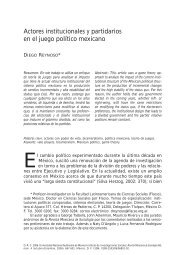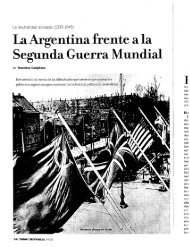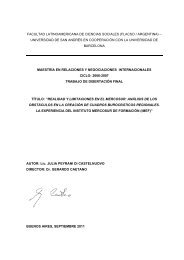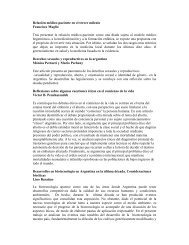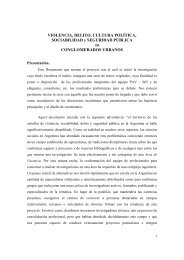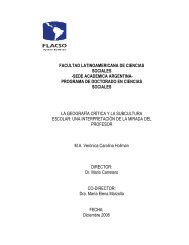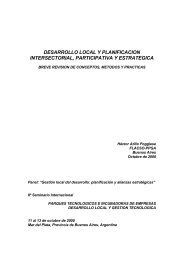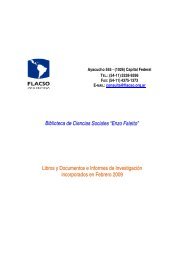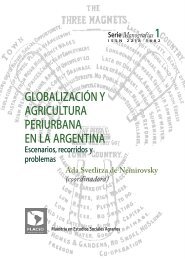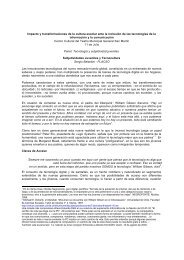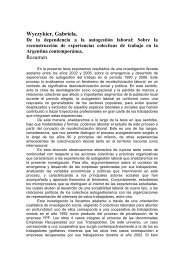Mercedes Botto Andrea Carla Bianculli - Flacso
Mercedes Botto Andrea Carla Bianculli - Flacso
Mercedes Botto Andrea Carla Bianculli - Flacso
Create successful ePaper yourself
Turn your PDF publications into a flip-book with our unique Google optimized e-Paper software.
dynamics of the political process, and assess the importance of the different factors that have<br />
contributed to these instances of policy change.<br />
3.1. THE CGP<br />
3.1.1. ACADEMIC PRODUCTION<br />
The initiative to sign a program of strategic cooperation and commercial integration was basically<br />
of a political nature.<br />
When the newly elected president, Raúl Alfonsín, asked both Dante Caputo – Minister of Foreign<br />
Affairs – and Oscar Romero – Undersecretary of International Economic Relations, Ministry of<br />
Foreign Affairs – to elaborate an integration project, his aim was to put an end to the old conflict<br />
hypothesis between Argentina and Brazil. Certainly, regional integration initiatives were not new.<br />
However, and being motivated by political and not commercial reasons, Mercosur was intended to<br />
go beyond previous experiences such as the Latin America Free Trade Association (LAFTA) and<br />
LAIA. The underlying purpose of re-establishing democracy and diminishing the relative<br />
importance of military factors mainly guided it. Finally, this is how the process advanced. There are<br />
macro-decisions, which imply a change of paradigm, and there are also micro-decisions, which can<br />
either be considered as being strategic or instrumental. Certainly, the agreement between Raúl<br />
Alfonsín and José Sarney falls within the first category given that it would initiate the move towards<br />
the common market within both countries17. During this first commercial integration initiative, the debt crisis of 1982 played a key role: it<br />
promoted closeness not only within the national governments, but mainly between Argentina and<br />
Brazil as well. Even if the debt crisis and the international financial institutions – the IMF and the<br />
World Bank – clearly demanded the initiation of a process of trade liberalization and the reform of<br />
the highly distorted tariff systems, the government opted for a process of deep integration, which,<br />
in terms of trade liberalization, entailed a minimum and negotiated opening with Brazil. The aim<br />
was to privilege the development of a productive project.<br />
According to the main actors involved in the process, this option was inspired by the European<br />
experience, which appeared as a successful case of regional integration, and by the lessons derived<br />
from the failure of LAIA. This is clearly expressed by Bruno, as cited in Campbell [1999: 74], who<br />
argues that “if we try to develop a model of multilateral integration – such as that of LAIA – we will just develop<br />
the minimum common denominator of what we can build together… if – on the contrary – we choose those countries<br />
we consider to be the most dynamic ones – Argentina and Brazil – and we attemtp to design a model of integration<br />
based on certain sectors of their economies, we will develop a model with a great degree of internal dynamism, and this<br />
is the key difference in terms of the traditional model”.<br />
Both the origin and evolution of this first approach to an integration project with Brazil were<br />
surrounded by worries. These had to do mainly with the damages the association will bring about in<br />
Argentina given the existing structural asymmetries between the new partners, and which derived<br />
17 Interview with public official.<br />
18




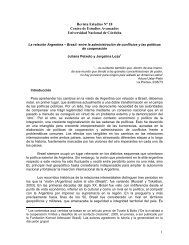
![[P] Disertacion.Melisa.Galvano.pdf - Flacso](https://img.yumpu.com/14596629/1/184x260/p-disertacionmelisagalvanopdf-flacso.jpg?quality=85)
